Rice Engineering Students Transform Old Truck into Electric Vehicle
Four teams of Rice University engineering students converted a 1997 Chevy P30 delivery van into a fully electric vehicle in less than a year, using a combination of parts scavenged from out-of-use vehicles, custom-built elements and off-the-shelf items.
With over 20 students involved overall, the electric conversion van project, or E-VAN, is a true feat not only in terms of engineering design but also timing and coordination. The students worked on E-VAN as part of their capstone design projects ⎯ an important part of the Rice engineering education that serves as an occasion to get hands-on experience developing and building solutions to concrete engineering challenges.
The project will compete in the annual Harrell and Carolyn Huff engineering design showcase and competition, which will take place 4:30-7 p.m. April 11 at the Ion. The event, which is open to the public, is an opportunity to experience the creativity and dedication of Rice undergraduate engineering students whose projects developed at the Oshman Engineering Design Kitchen (OEDK) translate classroom knowledge into functional engineering designs with a real-world purpose.
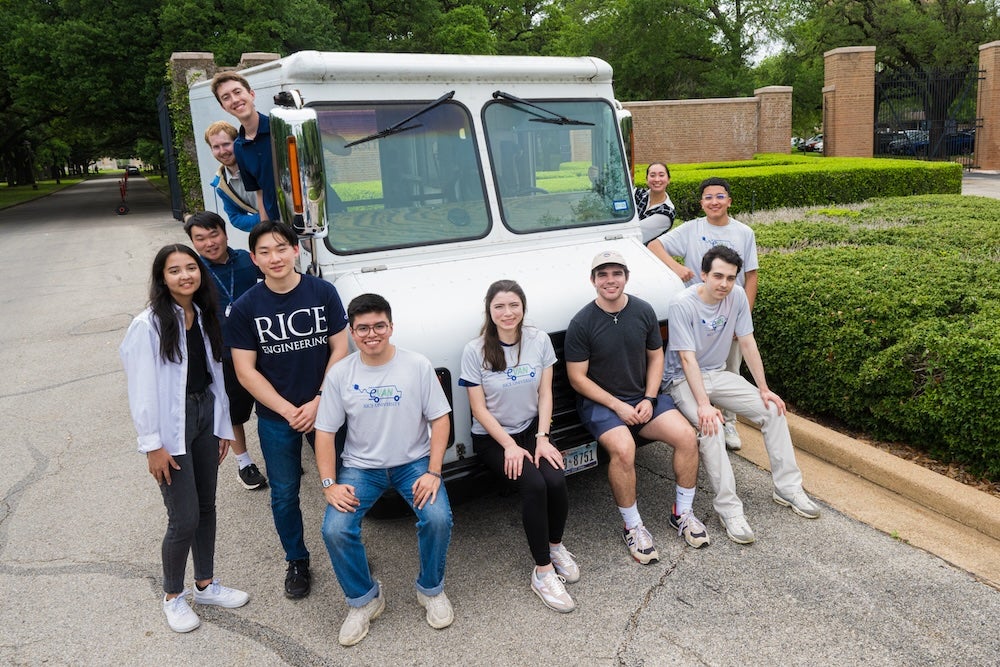
Because the project involved multiple teams working on it simultaneously, students had to navigate a complex timeline accommodating not only the design and execution of custom parts but also supply chain issues and delivery schedules for off-the-shelf parts. Another significant challenge was integrating all of the aftermarket parts into a single, functioning system and designing around their existing specifications. The project required a lot of coordination between all team members, serving as a crash course in advanced project management.
Powertrain
Rice University Powertrain Development, or team Powertrain, was in charge of the overall mechanics of the van such as steering and wheels as well as systems integration for the van as a whole. Rice engineering seniors Javier Alatore, Juan Vera Garza, Austin Greer, Diego Lopez-Bernal, Gerardo Rivera, Antoine Wiley and Lindsay Wright handled some of the project’s major design elements, including issues surrounding the battery and its housing, gearbox, motor and inverter specifications.
Greer, who has prior experience with electrical conversion work, was involved with the project from its earliest stages.
“The ‘why’ of this project for me is first of all because I like cars, and if somebody says, ‘Hey, let’s build a car,’ I’m going to say ‘yes’ no matter what it is,” Greer said. “But really, this was an opportunity to go all out on a capstone design project.”
The van has a maximum range of 100 miles on a highway and about 225 miles in inner-city conditions. Its top speed is about 86 miles an hour.
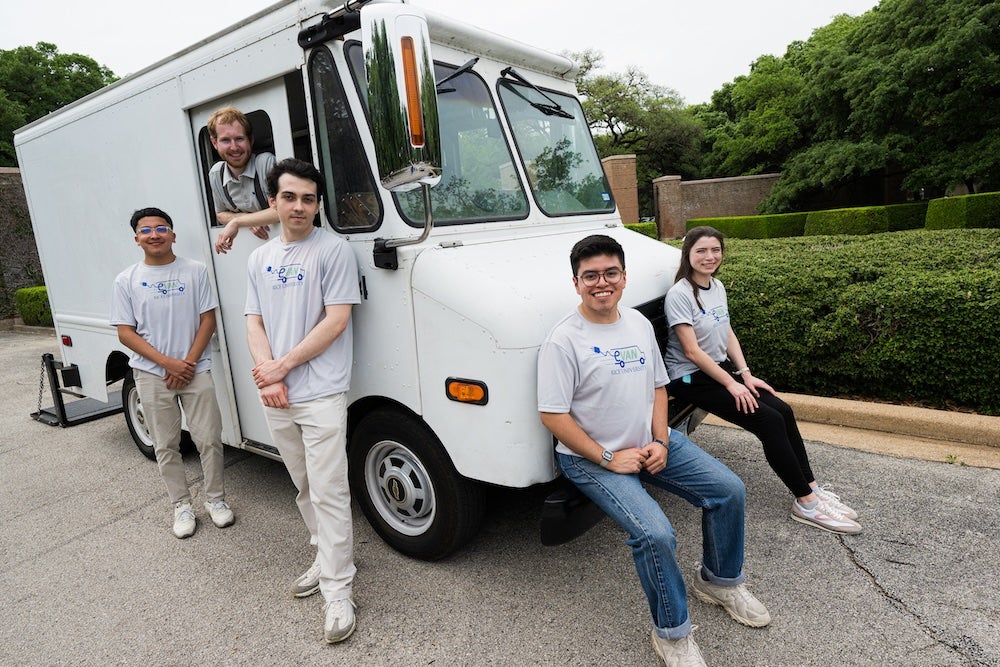
“That is actually pretty fast,” said Wright, who helped coordinate everything powertrain-related. “We’re really proud of how the project turned out. It’s probably one of the biggest and brightest things we’ve done at Rice.”
For Lopez-Bernal, the opportunity to get hands-on experience working on vehicles was one of the initial appeals of going to Rice.
“My dad actually flips cars for a living, so I’ve always been around cars, and I’ve always been interested in taking something that’s broken or maybe not in an ideal state and then making it into something more,” Lopez-Bernal said. “Especially here in Houston, which is such an important energy hub, getting to work on a project that relates to a lot of the broader conversations on energy was a great opportunity, and it was a lot of fun.”
Rivera emphasized the importance of getting to step out of the classroom and build a functional object to serve campus needs.
“It all came full circle, and it’s been quite a journey getting to put that knowledge to work on a project that will get to live on and get used daily,” Rivera said.
Electrical architecture
The Electric Vehicle Electronic Controls Design team, or EVAN Electronics, is made up of seniors Kirubel Ghebreab, Nathan Hsiao, Eric Press and Alois Chipfurutse. Their goal was “to design a robust, well-documented and scalable electronic control system that integrates all vehicle components” as well as the other systems “in addition to implementing autonomous driving and parking.”
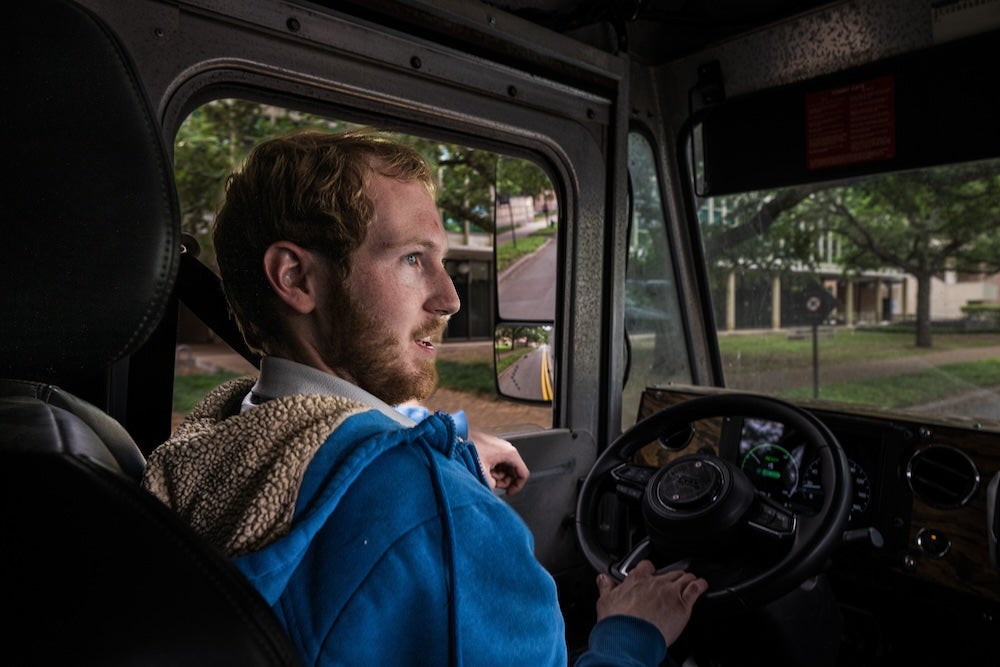
“This vehicle basically lives or dies by the electronics,” Greer said, highlighting the challenging task faced by the team in charge of the van’s electrical architecture, which has to interface with the thermal, power drive and dash components among other things. This was especially difficult given that many of the parts came from different types of vehicles.
“Being able to get these automotive components from other vehicles to function ⎯ and not just function but function in an integrated way ⎯ is a big deal,” Greer said. “If this truck works, it’s largely thanks to the electrical architecture. My favorite thing on this truck is something inconspicuous that you might not even notice, namely the blind spot sensors. It took hundreds of hours to get those sensors to work ⎯ they are one of the hardest things to integrate.”
Thermal system
Team Thermobile ⎯ made up of Maya Chhong, Olivia Goganian, Anisha Lal, Jacob Lee, Andrew Linhart and Ellie Schweiker ⎯ was in charge of the van’s thermal management system, including HVAC for the cabin/driver, electric motor and inverter cooling and electrical vehicle battery cooling. One of the innovative features of their design was using a dual-pump system and relying on pressure rather than a valve to direct fluid flow.
None of the Thermobile team members had any experience working with vehicles going into the project, so the first few weeks were spent just figuring out how air conditioning in cars worked. With only experience in thermodynamics from lectures, Thermobile was tasked with designing, procuring and installing a unique thermal system into the E-VAN.
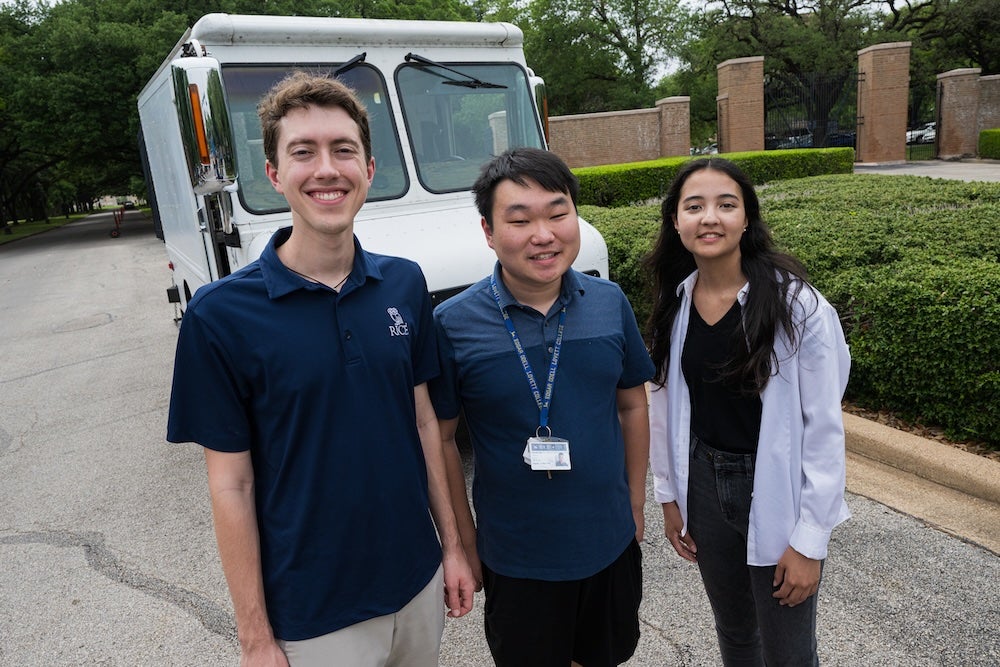
“It was a steep learning curve, but it was definitely worth it, because after that we were working so efficiently,” said Chhong, who together with Greer is one of the project’s early architects. “We’ve been going into the van several times a week, and we got to really wrench on it and actually use a bunch of tools I’ve never used before.”
Linhart, who plans on pursuing patent law after graduation, said he found it rewarding to interact with Rice’s technology transfer office and think of the project from the perspective of intellectual property rights. The team looked into securing a patent for their dual-pump design which is unique for electric vehicles, but the cost was prohibitive.
Lee, a mechanical engineering major with an interest in thermal fluids, said that despite the focus of their specific project area, the range of expertise that team Thermobile tackled reached well beyond just thermodynamics: Controlling the parts of their system required writing code and designing logic diagrams, while installing parts required hands-on skills and understanding heat transfer and stress analysis.
“This project really is a combination of all the mechanical engineering courses we’ve taken,” Chhong said. “It’s been really fulfilling to be using what we have learned in a real-life situation.”
Dashboard
Team Déjà Vu worked on the van’s dashboard, aiming for a “user-friendly and ergonomic design befitting of the E-VAN.” Freshmen Devika Dua, Aoife Shannon, Joseph Engelking and Evan Ho replaced the van’s old dashboard ⎯ which was completely nonfunctional and had to be ripped out ⎯ with a wooden dashboard equipped with a navigation panel, optimally-placed air conditioning vents and a custom digital instrument cluster that displays speed, battery level, regenerating power and more. Because it is the main user interface, the team took special care with the placement of the different elements to ensure both safety and comfort. A custom-built head unit provides wireless Carplay, Bluetooth and radio access, allowing users to play songs, select a radio station or navigate. The dashboard includes a number of custom parts as well as parts sourced from a junkyard.
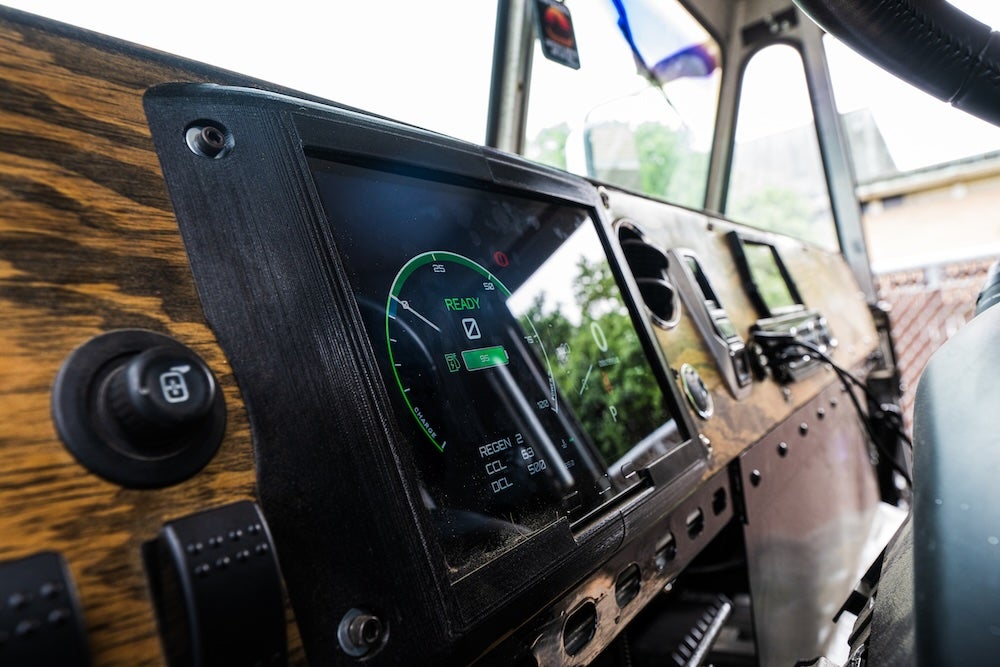
“I actually went to a junkyard and pulled these out of cars,” Ho said. “For example, we have a gear selector from a Honda Odyssey, a ‘push to start’ button from a Toyota Prius, the vents are from a Chevy HHR, etc.”
The team went on to 3D print custom ABS mounts to hold each component in the dashboard.
“We had to use computer software to 3D scan the parts to make sure that each part would fit,” Engelking said.
Shannon, who installed the metal framing holding the dashboard in place, said that the process kept team members on their toes up until the very end: A week before the team had to make their final prototype, they realized that the dashboard looked better if it was flipped around.
“Initially, it was supposed to be more angled to give us more space to work with,” Shannon said. “We had to completely reconfigure the designs and move everything around.”
The E-VAN project got started as a conversation between Richard Johnson, who serves as senior executive director for sustainability in Rice’s sustainability office, and Mark Ditman, who served as Rice’s vice president for housing and dining prior to his retirement in 2023 and as interim senior associate vice president for infrastructure, sustainability and services. The idea was to take an older van owned by housing and dining and turn it into a sustainability-related project. Initially, the suggestion was to do this as part of a class, but that plan did not pan out. Instead, David Trevas, a Rice mechanical engineering lecturer who mentors student teams on their capstone design projects, brought the idea of converting the van into an electrical vehicle to Greer, who in turn suggested turning it into a senior capstone design opportunity.
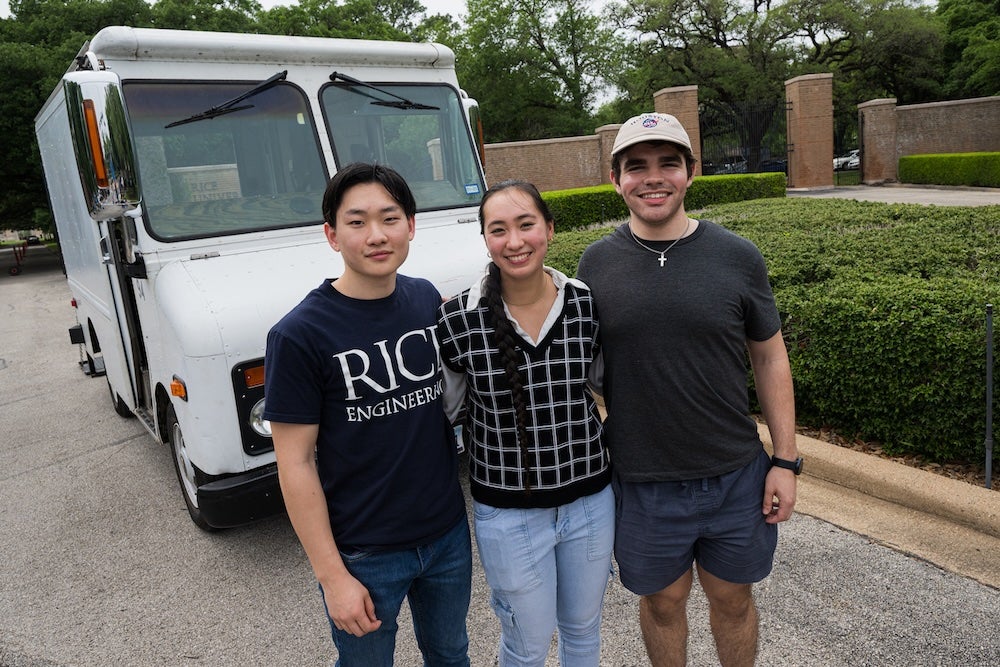
The E-VAN journey is far from over: The van will continue to serve as a platform for student projects, and the momentum from E-VAN has also spurred interest in reviving the Rice Society of Automotive Engineers (SAE) club to create a community around automotive vehicles and work on automotive projects at Rice.
“In the present, we are focused on restoring and overhauling nonoperational vehicles to functional capacity,” Ho said. “Our first project is a hybrid-electric conversion of a 2004 Porsche Boxster. Our long-term goal is to participate in SAE competitions.”
This project was supported in part through a generous donation from the Rice Housing and Dining Department.
Team mentors are Trevas and Gary Woods, a professor in the practice of electrical and computer engineering. Kevin Holmes, an OEDK lecturer, guided the dashboard team project during a freshman design class, and Roberto Dugnani, a lecturer in mechanical engineering, also has been mentoring the team over the past semester.

